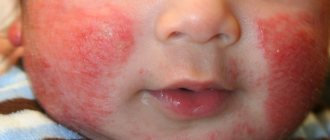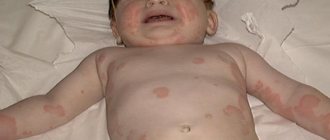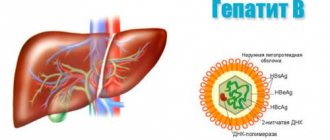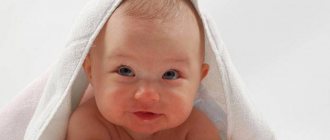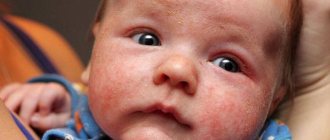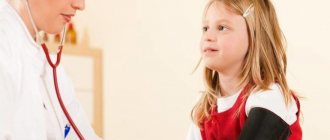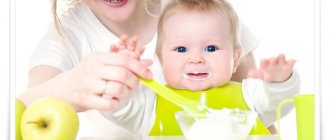Allergies on the cheeks in young children are a fairly common disease. Almost every baby suffers from allergic manifestations. The development of this disease is explained by the weakened immunity of the newborn child, when any substance that enters the body causes allergic irritation.
Most often, rashes on the cheeks appear due to food allergens. In medicine, cheek allergies in children are classified as diathesis. This condition causes discomfort to the child. The baby shows anxiety, is capricious and refuses to eat.
Allergic rashes on a baby’s cheeks most often appear at a very early age (3-6 months), manifesting themselves in the form of bright red spots, which require mandatory treatment if they occur.
Causes of redness on the cheeks of a child
The main cause of an allergic reaction on the cheeks is the peculiarity of the digestive system in newborns.
This promotes rapid absorption of unsplit molecules and especially proteins into the blood plasma. Due to its antigenic properties, an acute allergic reaction of the body occurs.
- The early introduction of complementary foods into the diet of infants provokes the appearance of allergies, since the digestive system is not able to absorb and digest them. In addition, very often there are cases of allergic rejection to force-feeding of children, when the child’s body does not absorb excess foods.
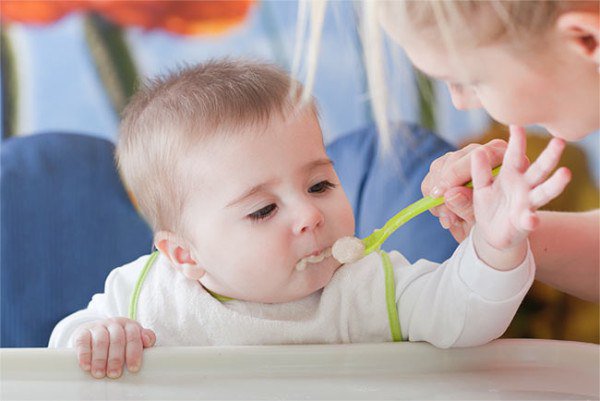
- An allergic reaction can occur to the presence of highly allergenic foods in a child’s diet (citrus fruits, strawberries, chocolate), as well as out-of-season fruits and vegetables that contain nitrates and chemicals added for faster ripening and preservation during long-term transportation.
- Allergies often occur as a result of contact with too bright toys and low-quality dyes on children's clothes. The body of a newborn child is not able to cope with incoming allergens.
- Rashes on the cheeks of a baby can occur as a result of contact with house dust, animals, household chemicals, such as soap, shampoos, air fresheners and laundry detergent for an adult. There are cases of allergies even to the water that flows from the tap, since chlorine is added to it for disinfection.
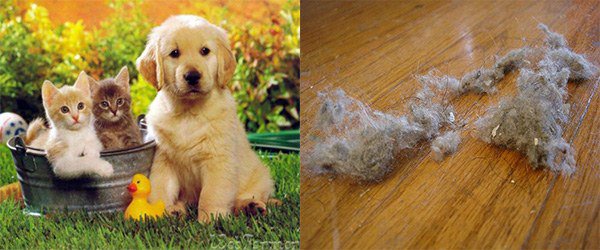
To prevent the occurrence of allergies, first of all, it is necessary to balance the baby’s diet, getting rid of all foods and things that provoke the appearance of rashes on the cheeks. As a rule, after measures have been taken, allergic symptoms in infants occur quite rarely.
Types of rash on the face with photos and its features
The most common causes of rashes are allergies and prickly heat. However, if you find pimples on a child’s face, you should not assume that they will go away on their own (see also: pimples on a child’s hands: causes of rashes and ways to eliminate them). A rash on the cheeks of a child may be a sign of an infectious disease (see also: rash on the legs of a child: causes and photos with explanations). Sometimes it lasts only a few hours, so if you notice a rash, you should immediately consult a doctor.
The rash can look not only like pimples, but also blisters. Red rashes occur as a result of an allergic reaction to food, flowers, or strong odors. Scarlet fever and rubella give a similar picture.
Bubbles with clear liquid appear with prickly heat. Similar blisters occur when infected with infectious herpes, but in this case they are concentrated in the mouth area. The appearance of small white pimples is characteristic of blockage of the sebaceous glands.
Colorless or white pimples in a child under one year of age appear when teeth are cut (we recommend reading: pimples on a child’s body: causes and photos with explanations). The reason for this is saliva flowing from the mouth. In one-year-old children, the possibilities of contracting an infectious disease are limited, but in older children, aged 7-8 years, the appearance of acne is pathological.
Whatever the rash, proper treatment and care are necessary for it to disappear. Failure to follow doctor's recommendations or improper treatment of pimples can lead to infection of damaged skin areas. The types of rashes that occur with various diseases are shown in the photo.
Allergic rashes in children
A newborn baby, having just left the womb, must adapt to life in the outside world. All systems of his body continue to develop and adapt to new conditions. This adaptation does not always go smoothly.
READ ALSO: Types of allergic rashes (spots) on the skin - what it looks like, how to treat it (photo)
The body of a baby under 1 year of age may not be able to cope with certain irritants, contact with which will cause an allergic reaction. In a baby, the body responds to the composition of breast milk; the reaction is caused by foods eaten by the mother. The period of introducing complementary foods, starting after 6 months, is especially dangerous in this regard. In addition to food, some other substances may be allergens:
- detergents;
- animal hair and skin particles;
- medications;
- household chemicals;
- cosmetics;
- pollen of flowering plants.
Food allergies usually cause rashes on the cheeks and chin. It looks like small red pimples or just red spots that are very itchy. Subsequently, the irritated areas become covered with a crust. Usually the general health remains normal, the temperature does not rise. However, prolonged contact with the irritant will lead to a deterioration in appetite, sleep disturbance, and the spread of rashes to the entire body.
Separately, it should be said about an allergic reaction to the sun. Keeping your baby outdoors in the sun can cause the nose and forehead to become covered with a colorless rash. This phenomenon is called solar keratosis.
Miliaria in a child
In extreme heat or when there is too much clothing, prickly heat appears on the baby’s face and body, which is caused by imperfect sweat ducts. The pimples and spots that appear may be reddish or white, and may also have the appearance of small flesh-colored blisters. Miliaria rubra is itchy or even painful, white heat does not cause any sensation, but later crusts appear in its place. On the forehead, rashes appear under the hairs.
Newborn acne
Red pimples in a child, concentrated on the head, are often observed in very young children. Dense papules resemble juvenile acne both in color and vascular pattern. This phenomenon is called neonatal acne. Pimples are located on the cheeks, forehead, nose, and can be found on the neck or ears, but do not affect the body. “Blooming” begins at 2-3 weeks of life; a 6-month-old baby usually no longer has it.
Acne occurs due to inflammation of the sebaceous glands. The level of subcutaneous fat in a baby depends on the hormonal levels of the mother. If hormone levels are high at the end of pregnancy, it can cause acne in your baby. Frequently, anxiety leads to increased production of hormones in women, which negatively affects metabolism. As a result, the baby increases the production of subcutaneous fat.
Such formations in newborns are a variant of the norm. If they appear after a year, you need to look for other reasons why your child has acne. In teenagers, blocked sebaceous glands can cause vesicles to form on the shoulders. This problem occurs in most children during puberty.
READ ALSO: How to quickly get rid of acne using black cumin oil
Erythema toxicum
Erythema toxicum is essentially the same allergy in a later and more severe stage. It occurs due to general intoxication of the body with an allergenic irritant. The disease most often occurs in newborns, although it occurs in people of all ages.
The disease causes the formation of red spots that occur due to the expansion of capillaries under the influence of an allergen. The causes of poisoning can be both external and internal:
- metabolic disorders lead to the production of a toxic substance in the body itself, this erythema is called autotoxic;
- taking a number of medications causes a medicinal form of the disease;
- most often the allergen enters the gastrointestinal tract with food, this form is called nutritional;
- contact of the allergen with the skin or mucous membrane leads to the appearance of contact erythema.
In newborns, the cause of the disease is usually the presence of a pathogen in the mother's milk. Difficult childbirth, problems during pregnancy, a woman’s tendency to allergies and her taking a number of medications increase the likelihood of erythema. In older children, the disease is caused by various reasons.
Erythema is divided into several types:
- with papular, small nodules or plaques form on the cheeks, rising above the surface of the skin;
- The mildest form is considered to be spotty - red spots appear on the face;
- pimples, which are subsequently replaced by crusts, indicate vesicular erythema;
- Large, bloodshot nodules with jagged edges are called erythema nodosum.
Rash due to various infectious diseases
A child may get sprinkled not only due to contact with an irritant. Many infectious childhood diseases cause rashes. Their appearance suggests one or another diagnosis, which tests will help confirm. Below are the most common childhood diseases that cause rashes, as well as photos with explanations:
- Chickenpox is caused by the herpes virus. The cheeks, forehead, nose, scalp and body are covered with sparse single-chamber vesicles. Pimples soon burst and crusts form in their place. The process occurs in parallel with the appearance of new vesicles.
- Measles - it is characterized by the appearance of rashes on the 3-4th day of the disease, but there are cases of skin manifestations on the 2nd or 5th day. First, the rash appears on the bridge of the nose and behind the ears, then it spreads to the face and neck, and later the body, arms and legs become covered with acne. The rash is abundant, at first individual spots appear, which then merge.
- Rubella is a viral disease accompanied by swollen lymph nodes and an infectious rash. Small red pimples in a child appear on the face, then slide down, covering the body and limbs (we recommend reading: why can pimples form on the palms of a child?). The disease can cause serious complications and is very dangerous for the fetus during a woman’s pregnancy.
- Scarlet fever is a dangerous childhood disease caused by streptococcus. The rash appears on the first or second day of illness and plays an important role in diagnosis. First of all, it covers the face, then the bright rash spreads to the neck, torso, arms and legs, and gradually fades. A characteristic sign of the disease is pimples on the child’s cheeks, bypassing the nasolabial triangle. This area remains white with bright red rashes on the forehead and cheeks, which immediately makes one suspect scarlet fever.
- Severe rashes on the face also occur with infectious mononucleosis. The rash may appear on the 3-5th day and consists of spots and papules. It appears chaotically, anywhere on the body, does not itch, and disappears within a few days, leaving no trace.
READ ALSO: Black dots on the face of a baby: reasons for their appearance and what to do | ru-babyhealth
Rashes can accompany hepatitis B, be associated with enterovirus infection, or occur with other infectious diseases. At the first formations on the skin, you should carefully examine the child and record the location of the pimples, as this will help with diagnosis.
Pimples due to dermatitis
Acne with atopic dermatitis causes severe itching. Primary pale pink or flesh-colored nodules merge into large spots, up to 5 cm in diameter. Against this background, bubbles filled with liquid appear. Constant itching gets worse with stress or eating intolerant foods. The causes of the disease are hereditary and associated with intolerance to environmental conditions and allergies.
Allergy symptoms on the cheeks
With the development of the disease in the cheek area, the clinical picture is manifested by the following symptoms:
- hyperemia in the affected area of the skin;
- inflammation of the mucous membranes of the mouth, eyes and nose;
- enlarged lymph nodes;
- a sharp increase in body temperature;
- restless behavior of the child.
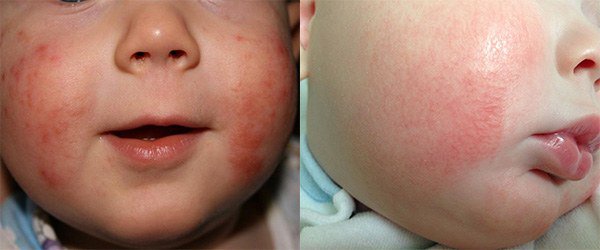
Small rashes on the cheeks with watery contents. Sometimes the blisters open and an inflammatory focus may form. Quite often, allergic symptoms develop into eczema, atopic dermatitis, etc.
Types of rash
But food allergies in infants are not the only cause of rashes. There are also diseases such as:
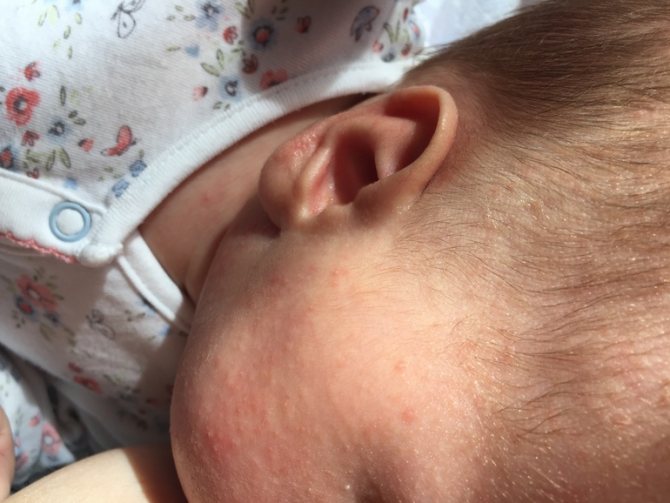
Hormonal rash. This type is medically called neonatal acne. It is not contagious and is completely safe for others. This disease is treated by taking medications. Most often, acne appears on the scalp and face. Pimples may be barely noticeable, but more noticeable when touched. These are not purulent pimples, but simply dirty pores. They arise due to the fact that fungi are present on the child’s body, which are normal. It is strictly forbidden to get rid of such a disease with the help of lotions and compresses.- Miliaria can cause red spots to appear on a baby's body. The causes of the disease can be different, for example, overheating, improper care, or if the child is in wet or damp clothes for a long time. In order to avoid such a problem, it is necessary to constantly monitor the temperature in the room and bathe the child more often. There are no special recommendations for the treatment of prickly heat; it is enough to take baths with chamomile or calendula. You can simply wipe problem areas of the skin with herbal decoctions or dill water.
- Contact allergy or dermatitis. It differs from other types in that a small red rash appears on the face and body, similar to irritation. The most common cause of contact allergies is hygiene products or laundry detergents. It is not difficult to determine: it appears in those places where the body comes into contact with clothing. To prevent it, you must use only hypoallergenic products.
- The least common is roseola. This disease is infectious. The main symptom is high body temperature, which is difficult to break down. After the temperature stabilizes, a rash appears on the cheeks of the infant. The disease cannot be treated with medication; it goes away on its own.
- If a small rash appears on the face of a 1-month-old newborn, it is most likely scarlet fever. In addition to the face, it eventually appears on the back and stomach. This disease is transmitted by airborne droplets. Self-treatment in this case is prohibited; everything must be done under the supervision of a doctor.
- Acne on the face of newborns may appear due to measles. Measles is easy to distinguish from other diseases. It is characterized by bright color and large size. It initially appears behind the ears, and then spreads throughout the body in the form of papules. At the first symptoms, you should immediately consult a doctor and the best option is hospitalization.
Treatment
An allergic disease must be diagnosed by a qualified specialist in this field, who is able to determine the best way to treat the disease. As a rule, in each case, individual treatment tactics for children are selected, primarily involving the exclusion of contact with allergens.

- In almost every case, it is recommended to prescribe antihistamines. Unlike the treatment of an adult patient, it is preferable to use liquid solutions (drops, syrup) for a child. They are most convenient to use for a child and do not cause negative side effects. The required dosage depends on the age of the baby, the general condition of the body and the severity of severe symptoms.
- Some of the most common medications for relieving allergies in infants are Polysorb (enterosorbent) and Fenistil (drops, ointment). Pediatricians often advise combined treatment with simultaneous lubrication of the rash-affected cheeks and ingestion of antihistamine drops. Polysorb is prescribed to quickly remove various allergens from the body. In addition, its advantage is its inability to be absorbed into the blood. Therefore, this enterosorbent is considered to be the safest, which is approved for use for children from the first days of life.
ethnoscience
Some parents prefer to cope with allergies in their newborn child using traditional medicine. However, it should be remembered that even the most harmless drugs, including herbs, have their contraindications, so before treating allergic manifestations in a baby, a preliminary consultation with a doctor is required so as not to harm the baby’s body. It is important to remember that such treatment is carried out with caution in young children.
We should not forget that treatment of infants with medicinal herbs cannot completely replace drug therapy. Allergies need to be treated comprehensively, using all means. Only in this case will the treatment be successful.
Compresses and lotions using pharmaceutical chamomile, thyme, and celandine have a good effect when treating a newborn baby. These herbs help quickly get rid of red spots on the cheeks.
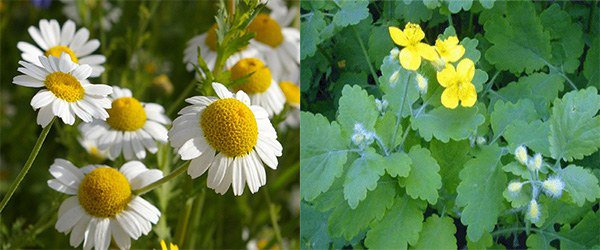
Compliance with preventive measures is of great importance. You should adhere to a hypoallergenic diet, excluding harmful foods from your child’s diet.
In addition, it is recommended to promptly neutralize an acute attack of allergies, avoiding complications. And most importantly, all therapeutic measures should be carried out only with the permission of the attending physician. Only with this approach can antigens be removed from the patient’s body.
Atopic dermatitis in children
A fairly common cause of a rash on the cheeks of a child is atopic dermatitis. This is a chronic inflammatory skin lesion that is allergic in nature. As a rule, atopic dermatitis first appears in an infant after 2-3 months and often goes away by 3-4 years. However, for some children it can remain for life.
The main symptom of atopic dermatitis is redness of the cheeks, their dryness and peeling; itchy nodules with transparent contents and other types of rashes often appear. Children with this pathology often have constipation or diarrhea, and they have a more difficult time suffering from colds and other diseases.
Why does atopic dermatitis occur in children? Experts explain its appearance by the immaturity of the baby’s digestive system and internal problems in his body. At the same time, some substances entering the body are not absorbed. The intestines cannot digest them, the liver cannot neutralize them, and the kidneys or lungs cannot eliminate them. As a result of specific reactions, such substances acquire the properties of antigens and provoke the production of antibodies. The appearance of a rash is caused precisely by the antigen-antibody complex.
The most common allergens are food products. In addition, detergents, dust, synthetic clothing and many other factors can cause an allergic reaction. Only a doctor can determine the exact cause of atopic dermatitis, although it should be noted that in some cases the provoking factor is never detected.
What should parents do if the cause of a rash on their child’s cheeks is atopic dermatitis? The first condition for successful treatment is elimination of the allergen. Sometimes this is enough to reduce the manifestations of pathology and their fairly rapid disappearance.
If the baby is breastfed, the mother should reconsider her diet. Potential allergens should be excluded from the diet. These include citrus fruits, red and orange fruits and vegetables, chocolate, nuts, products containing dyes, preservatives and flavors.
If rashes appear during the introduction of new complementary foods to the baby, they stop giving them. For some time after the rash appears, there is no need to introduce new complementary foods to the child at all. You should wait until the rashes and other allergic manifestations disappear completely.
To prevent the development of contact allergies, it is necessary to avoid synthetic detergents, shampoos and soaps with artificial fragrances and dyes. The child should wear clothes only made from natural fabrics.
In severe cases of atopic dermatitis, the doctor prescribes drug therapy for the baby. As a rule, these are antihistamines, enzymes and vitamins. Non-hormonal and hormonal moisturizing creams and ointments can be used for topical application.



